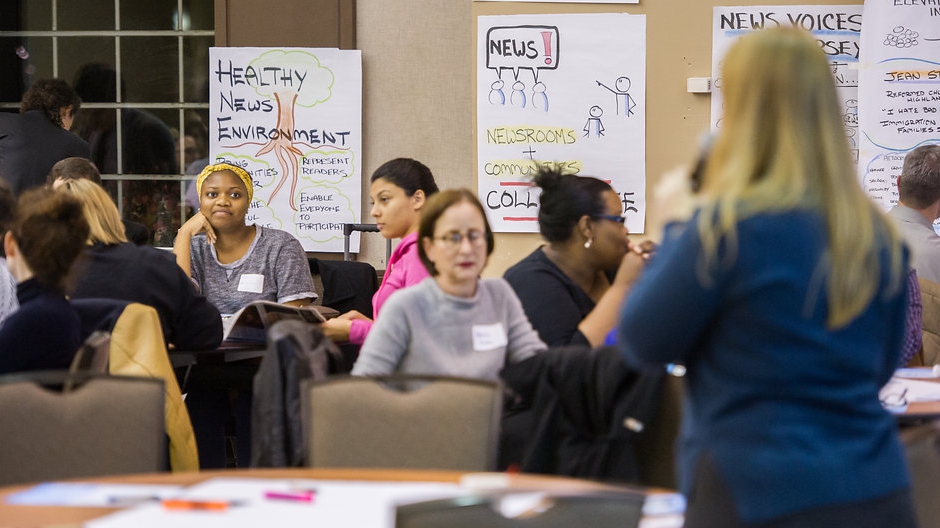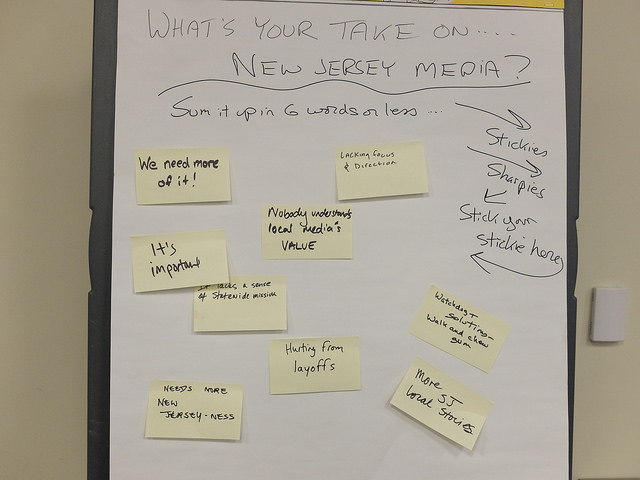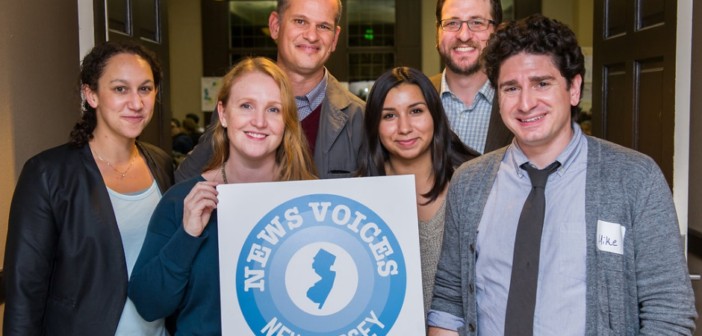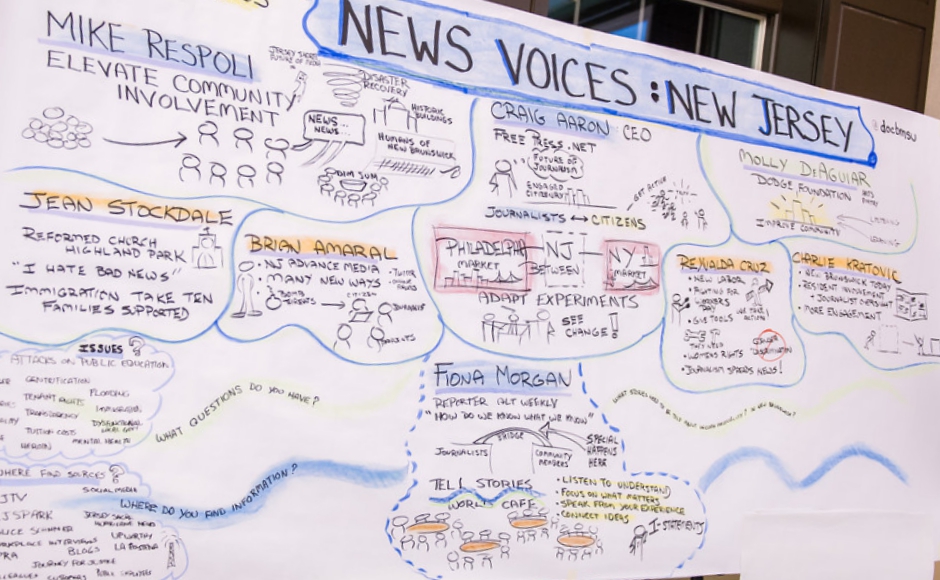With a $332-million windfall from the sale of unused public television licenses, media advocates are organizing around the opportunity to support public-interest news and information gathering efforts.
By Matt Skoufalos | May 5, 2017

News Voices New Jersey convened multiple panels statewide about the state of community journalism. Credit: Brad Resnick.
New Jersey just got $332 million from a nationwide auction of two public broadcasting licenses: WNJN Channel 51 in Montclair, which sold for $194 million, and WNJT Channel 43 Trenton, which netted $138 million.
Two others, WNJB Channel 8 New Brunswick and WNJS Channel 22 Camden, didn’t sell (see NJ.com’s wrap-up here).
News Voices New Jersey is trying to convince lawmakers to dedicate those funds (or, more realistically, a significant portion of them) to the preservation of New Jersey-focused journalism and community information.
Backed by the nonprofit Free Press, the group wants lawmakers to use those dollars to create a public trust fund dedicated to strengthening relations between journalists and the communities they serve. (UPDATE: legislation to establish this Civic Information Consortium was introduced in late May. More here.)
Former Philadelphia Inquirer and WHYY-FM journalist Chris Satullo is working as a civic engagement consultant to Free Press Action Fund on this initiative. We spoke with him about the thinking behind the project.
NJ PEN: Why were these licenses auctioned off, and why did they bring in so much money? What are business conditions are like for public television in New Jersey?
CHRIS SATULLO: Stick with me here. The answer gets a little complex.
The auction was proposed and run by the Federal Communications Commission (FCC). Nowadays, five out of six Americans use cable or streaming, or both, instead of over-the-air television.
So the FCC decided that some of the bandwidth devoted to broadcast TV could be better used by telecom providers like Verizon, Sprint, and AT&T to improve their video streaming services.
The idea was to buy back pieces of broadcast spectrum from broadcasters who no longer need it to reach their audiences, and sell those chunks of bandwidth at a profit to telecom companies.
The auction didn’t bring in nearly as much as the FCC had hoped, but it did garner $19.6 billion, $10 billion of which went to broadcasters, with the rest going to the U.S. Treasury and to cover costs associated with the auction.
The New Jersey licenses were unusually valuable become of the state’s location in the middle of the eastern megalopolis, where so many smartphone and iPad users live. They brought in the number 1 and number 4 prices among all public TV licenses nationwide.
New Jersey is also unique nationally in that it’s the only owner of public TV licenses from stations that had already decided to get out of the public TV business back when Governor Christie shut down the New Jersey Network (NJN). The state will continue to lease the two unsold channels to WNET public TV out of New York, which will keep running the NJTV service that replaced NJN.
So the good news is that the state got the $332 million free and clear, with none of it tied up in the costs of continuing public TV services. That’s also the bad news for proponents of public interest media, because the governor and the legislature can spend the money on anything they want, and the state budget has a lot of holes that need filling.

News Voices New Jersey convened multiple panels statewide about the state of community journalism. Credit: Brad Resnick.
NJ PEN: Free Press Action Fund is advocating for this money to be reinvested, in whole or in part, into journalism. What’s the argument for doing this?
SATULLO: First, let’s remember a key fact. These are in fact the public’s airwaves that are being bought and sold.
TV stations hold them in trust, and make money off of them, but make no mistake: these airwaves belong to us.
It’s really no different from public parkland or a library building being sold. In those cases, wouldn’t you want to be sure that at least some of the proceeds were being used for some public purpose related to parks or literacy?
Some wise lawmakers in the middle of the 20th century decided to reserve parts of the public’s airwaves for public-interest media—what we have come to know as PBS and NPR; as Frontline, Downton Abbey and Sesame Street; as Terry Gross, Ira Glass and the Car Talk guys. In other words, those long-ago lawmakers innovated to promote public service in the age of broadcasting.
These are the public’s airwaves that are being bought and sold. These airwaves belong to us. It’s no different from public parkland or a library building being sold. Wouldn’t you want at least some of the proceeds used for some related public purpose?
–Chris Satullo, News Voices New Jersey civic engagement consultant
Now, through this windfall, New Jersey has a chance to become a national model for how to build out public-interest media for the digital age. It’s a chance for New Jersey to move (in media terms) from stepchild of the Big Apple and Philly to star player.
The information action may have moved from newsprint to iPhones, but community members’ needs haven’t changed. At forums like the ones we held recently in Camden and Glassboro, people of all ages still say they want someone to watchdog how their tax dollars get spent, to celebrate their community’s heroes, to reveal and explain its problems, and to point to solutions.
And they want someone to sift through the digital flood of information for them, cull out the junk and the lies, and point them to the worthwhile and the true. They want, in short, what journalists have always done. They just want it done in ways that respond to their needs, and that work with the devices through which they live their lives.

What do people think about the current state of local news in six words or less? Credit: New Jersey News Voices.
So, to help make that happen, the Free Press Action Fund would like to see a significant chunk of that $332 million put into a civic information fund.
This continuing endowment would make smart, targeted investments in community-focused initiatives to meet your information needs as a resident of New Jersey.
This could well be about supporting existing or budding journalists with innovative ideas.
It’s definitely about preserving the kind of serious community journalism that NJ Pen offers. But the fund’s grants need not be limited to traditional journalism. It could also invest in civic technology or civic engagement projects, or other community-generated ideas I’m not smart enough to imagine.
To be very candid and clear, this is definitely not about propping up or subsidizing the operations of corporate news chains based in other states that have hit hard times and laid off a lot of their New Jersey staffers.
NJ PEN: What are the best ways that Free Press Action Fund and its supporters think this money could be used? Is it more important to establish replacements for some of the services that public broadcast media would have provided, or to support existing entities?
SATULLO: Let me answer this by distilling what citizens of South Jersey have told us they want at the forums we’ve held.
Over and over, they say they would like to see a multimedia news service based in South Jersey whose sole reason for being was serving South Jersey. They imagine this service would do some original reporting, and then curate good stories from other sources.
They want this service to provide a steady mix of watchdog investigation and positive news. They’d like it to draw the connections between national and global events and local interests. They’d like it explain what happens in Trenton in terms they can understand and can connect to their daily lives.

New Brunswick Today editor Charlie Kratovil (left) and Camden community activist Sean Brown. Credit: Brad Resnick.
How best to do that in ways that create sustainable newsrooms that enable journalists to make a living wage and grow in the craft?
Well, that would be up to staff of the fund, and the experts they’d consult, to figure out along the way.
Undoubtedly, there would be some trial and error. But avoiding preconceived notions is one way to avoid big mistakes.
NJPEN: What’s the legislative advocacy for this civic information fund?
SATULLO: We’ve received some encouraging reactions from key lawmakers, who’ve helped us develop the idea into a bill that should be introduced shortly in both the Assembly and the Senate. The bill calls for the creation of the New Jersey Civic Information Consortium, a nonprofit that would direct the fund, with oversight from an appointed board and heavy involvement from four state research universities: Rowan, Rutgers, Montclair and New Jersey Institute of Technology.
A key point: The nonprofit would be set up so it could seek and accept foundation grants and private donations to supplement whatever public funds Trenton provides.
The bill would need to be passed by June 30 in concert with passage of the state budget, or we’d have to start over again next year after the state elections this fall.
NJPEN: How can people who believe in this effort support it?
SATULLO: Several ways:
1. Get all the information you need on the New Jersey initiative at our website.
2. Attend one of our community forums.
We’ve got one planned for May 16 at Montclair, another May 30 on the Rutgers New Brunswick campus, and others planned before June 15 for Asbury Park, Long Beach Island, and Bergen County.
3. Call or write your lawmakers, Assembly and Senate, to tell them you support the New Jersey Civic Information Consortium, and why.
4. Become a Free Press member and get regular updates about engagement activities, including rallies and “lobbying days” in Trenton.
5. Talk to your friends. Tell them what you’ve learned about this effort and urge them also to do steps 1 through 4 above.
NJ PEN: If the money doesn’t get reinvested into local media, what are the next strategies to help sustain or create valuable local journalism in New Jersey?

Chris Satullo (left) chats with a guest at a community meet-up about local news. Credit: News Voices New Jersey.
SATULLO: It’s a great question. We believe the fund and consortium idea will eventually be approved, hopefully this year.
But even if the bill does not pass this spring, the work done around this project to develop a New Jersey-focused, innovative vision for public interest media in the digital age will not go to waste.
Even though the opportunity presented right now by the auction windfall will soon evaporate, the effort to get some form of state support for this fund can continue.
Also, the effort has already attracted notice from major national foundations; perhaps one or more of them would be willing to invest in a pilot project to try a few of the innovations that have been proposed around this effort.
In the digital age, when it comes to media innovation, New Jersey no longer has to take a back seat to any other city or state. This site itself is a sign of the kind of journalistic ferment that has earned the state national acclaim and sets it up to be a leader in the digital age. New Jersey just has to put a little will and a little wallet behind the effort.
Get more local news that matters. Check out NJ Pen on Facebook and Twitter, or click here to become a supporter.






